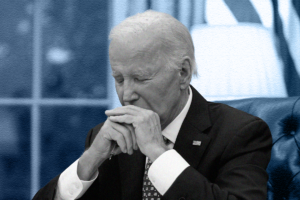‘Everything Around Me Was Getting Torn Apart’: Israel Strikes Another ‘Safe Zone’
The massacre at al-Mawasi is the latest in a string of targeted Israeli strikes on displacement camps across the Gaza Strip. Palestinians look at the destruction after an Israeli airstrike on a crowded tent camp housing Palestinians displaced by the war in the Gaza Strip on Sept. 10, 2024. (AP Photo/Abdel Kareem Hana)
Palestinians look at the destruction after an Israeli airstrike on a crowded tent camp housing Palestinians displaced by the war in the Gaza Strip on Sept. 10, 2024. (AP Photo/Abdel Kareem Hana)
Flashlights in the hands of rescue workers break the dense darkness over the sand in al-Mawasi, the tent encampment sheltering displaced Palestinians in Khan Younis. A group of men with shovels struggle to remove sand in the middle of a giant crater created by an Israeli airstrike on the Israeli-designated “safe zone.” In video testimony collected for the news website Mondoweiss, rescue workers pull out half-buried blankets from the sand and explain that they are trying to dig people out of the massive crater that was caused by an Israeli airstrike.
The Israeli massacre at al-Mawasi in the early hours of Sept. 10 is the latest in a string of targeted Israeli strikes on displacement camps across the Gaza Strip, alongside the bombing of school shelters. The massacre has claimed the lives of at least 40 Palestinians and injured 60 others, according to the Gaza-based Ministry of Health. This is also the second major massacre in the Mawasi “safe zone” and the fifth overall in the area. The first took place in July, killing 90 Palestinians. In that attack, Israel claimed to be targeting the leader of Hamas’ Qassam Brigades, Muhammad Deif. In the most recent attack, the Israeli army claimed to be targeting a Hamas command center.
According to the Euro-Mediterranean Human Rights Monitor, the latest massacre at al-Mawasi was carried out with U.S.-made bombs with “a wide destructive capacity.” The UN secretary general, the UN coordinator for humanitarian affairs in Palestine, and the EU chief of diplomacy have all condemned the attack.
Attack with no warning
“They told us to move to al-Mawasi, so we came to al-Mawasi,” a middle-aged man in a blue undershirt told Mondoweiss in the wake of the attack. “They gave us no warning. They didn’t tell us to move or that this was a combat zone. They hit us completely by surprise.”
“I woke up looking for my children, and then I walked out and saw people scattered. One dead over here, another over there,” he continued, pointing out a crater that was at least 20 meters wide. “Of course, there are more people under the sand, but we’ll only know in the morning.”
“They gave us no warning. They didn’t tell us to move or that this was a combat zone. They hit us completely by surprise.”
“Those here are poor people fleeing the bombing,” another elderly Mawasi local said. “Some of them pay rent for the place they are in, others are allowed to stay for free, but they are all regular people. None of them are part of the resistance or anything.”
“We pulled out many martyrs and injured. There are still many more under the sand, but most of them are women and children,” he exclaimed.
Over the past several weeks, the Israeli army has reduced the areas it has designated as “safe zones” in Gaza to less than 30% of the strip’s surface. Over 1 million people, or half of Gaza’s population, are forced into these small areas. When the Israeli army bombs these encampments, entire families are often killed.
Israeli bombs change the landscape
Although the Israeli army claims that each attack that leads to a massacre is targeting Hamas, the encampments are largely makeshift with little infrastructure that could presumably be used by Hamas as “command centers.” At al-Mawasi, Palestinians have installed improvised toilets in between tent groups, the only existing structures aside from fragile tents. When Israeli bombs drop on these areas, they effectively change the landscape of the area.
At al-Mawasi, Palestinians have installed improvised toilets in between tent groups, the only existing structures aside from fragile tents.
“The explosion was so strong that even water came out of the ground,” a displaced survivor told Mondoweiss. “There are only tents around us, nothing else. Imagine yourself sleeping when all of a sudden you find out that everything around you is being torn apart. Of course we were shocked! I couldn’t see anything or anyone in front of me at first,” he adds.
“There were five tents here,” he said, pointing to one of the craters. “And then four tents over there, and a couple of toilets on that side.”
“I woke up and found myself covered in blood,” another survivor with a bandage on his forehead and half his face burnt from a previous incident said. “I ran screaming, calling for my family, only to find that the nearby house collapsed on them, but thank God they all survived.”
“They [the Israeli army] had bombed another encampment on the other side, and the house over here collapsed on people,” he added breathlessly. “I don’t know what else to say. God help us.”
Hassan Suleih collected testimony for this report.
Your support matters…Independent journalism is under threat and overshadowed by heavily funded mainstream media.
You can help level the playing field. Become a member.
Your tax-deductible contribution keeps us digging beneath the headlines to give you thought-provoking, investigative reporting and analysis that unearths what's really happening- without compromise.
Give today to support our courageous, independent journalists.








You need to be a supporter to comment.
There are currently no responses to this article.
Be the first to respond.